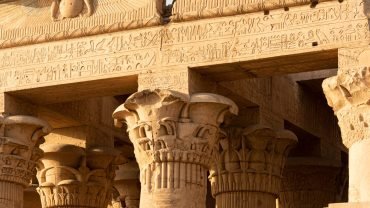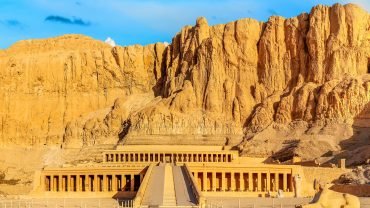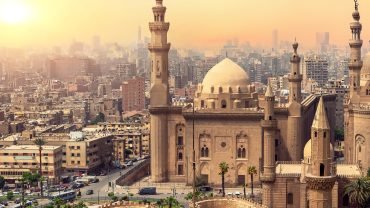Take a trip 3,000 years back in time to Ancient Egypt on a luxury Nile cruise. Float past highlights including the Valley of the Kings, home to the tomb of Tutankhamun, the Colossi of Memnon and the Karnak Temple.
You can now book an exclusive adventure with Culture Trip to take in all these sights and more on our specially curated 10-day Egypt adventure, led by our Expert GUIDE…
Embrace the joy of slow travel with a traditional cruise down the River Nile. The stretch between Luxor and Aswan is the most popular route for good reason. It’s the best way to see the most extraordinary monuments from Ancient Egypt. Here, we’ve selected the key sights you won’t want to miss. Get ready to play your most memorable game of I Spy.
Valley of the Kings
A Nile cruise staple has to be the Valley of the Kings on the west bank, near Luxor. It has been the site of royal burials since around 2100BCE and is famously home to the tomb of Tutankhamun. Head underground to discover the boy king’s glittering sarcophagus, alongside the tombs of Seti I and Ramses II. Over the years, the tombs have suffered from floods, treasure hunters and, most recently, humidity produced by hot and sweaty tourists. Bring a fan!
Mortuary Temple of Hatshepsut
This temple is almost hidden under dramatic rugged limestone cliffs that rise nearly 300m (985ft) above the desert plain at Deir el-Bahri in Upper Egypt. It’s named after Queen Hatshepsut, who declared herself a pharaoh and ruled as a man for over 20 years. You can see her portrayed with a male body in statues and paintings on site. It is one of the most modern-looking of the rock temples in Egypt today and was first excavated in 1891.
Colossi of Memnon
It’s impossible not to notice the Colossi of Memnon on the west bank from the comfort of your Nile cruise. It consists of two enormous 18m-high (60ft) stone statues of the pharaoh Amenhotep III, who reigned in Egypt during the 18th Dynasty of Egypt. Since 1350BCE, they have stood in the Theban Necropolis, located near the city of Luxor. The statues are faceless, which gives them a rather eerie quality. Tourists have been visiting since Greco-Roman times, when people believed hearing the whistling sound emitted by the northern statue at sunrise was good luck.
Karnak Temple
There are actually three main temples in this mother of all sacred buildings, the largest religious site in the world. More than 3,000 years after it was first built, it remains one of the most awe-inspiring ruined temples in Egypt, with pylons, sacred lakes and chapels spread over 200 acres (81ha). At its heart is the Temple of Amun. The Luxor and Karnak temples were once linked by a grandiose 3km-long (1.9mi) avenue lined with sphinxes.
Souq of Luxo
For a truly authentic shopping experience, head to the main souq (street market) in Luxor. It runs along a narrow pedestrian street, with tiny shops and cafes jutting off it. Here, you’ll find everything from dazzling jewellery to rose petals and red glossy apples. Be sure to venture beyond the tourist bazaar just off Sharia Al Mahatta, where locals shop for fabrics and groceries. The souq is open daily from 7am until midnight; it’s at its liveliest in the early evening.
Temple of Horus at Edfu
This is the second-largest temple after Karnak, and it took 180 years to build it. The sandstone Edfu temple is located on high ground above the broad river valley on the west bank of the Nile. It escaped destruction from Nile floods and is now one of the best-preserved monuments in Egypt. Among its main highlights are the imposing Hypostyle Hall and a small chapel called the “birth house”. Today, the town of Edfu thrives on sugar and pottery trades.
Temple of Kom Ombo
Ever been to a crocodile museum and an ancient Egyptian temple in one day? Kom Ombo Temple sits on a bend in the Nile, where sacred crocodiles once basked in the sun. Unusual for an Egyptian temple, it’s dedicated to two gods: the local crocodile god Sobek, and Horus the Elder (Haroeris). It was built during the Ptolemaic Dynasty in 180–47BCE. A path links the ruined temple with the air-conditioned Crocodile Museum and its collection of mummified crocodiles.
Abu Simbel Temples
Abu Simbel is actually comprised of two gigantic rock-cut temples, carved out of the mountainside by the Egyptian king Ramses II. It overlooks Lake Nasser near the border with Sudan. The complex is part of the Unesco World Heritage site known as the Nubian Monuments, which runs from the village of Abu Simbel downriver to Philae (near Aswan). It does take three hours by bus to get there, but seeing the enormous monuments up close makes the journey worth it.




Comment (0)